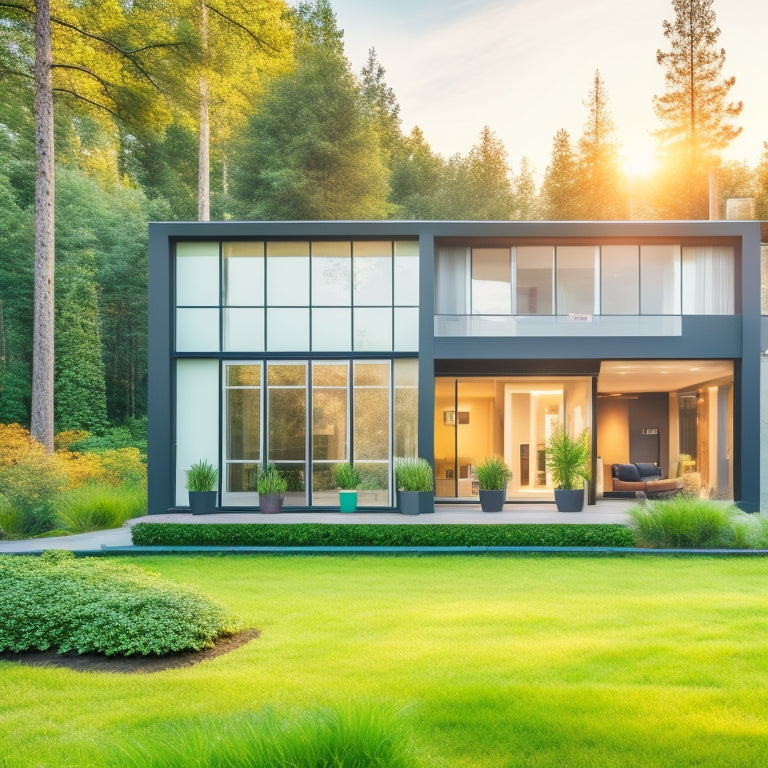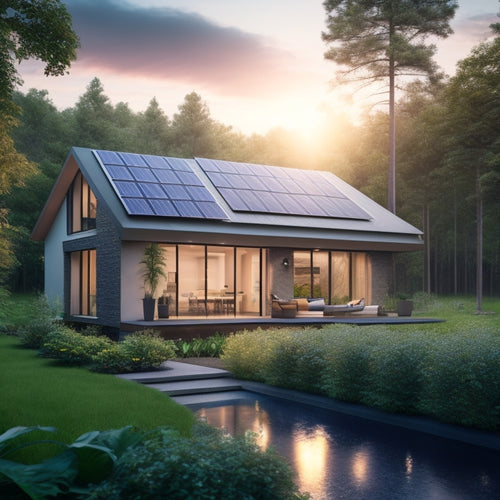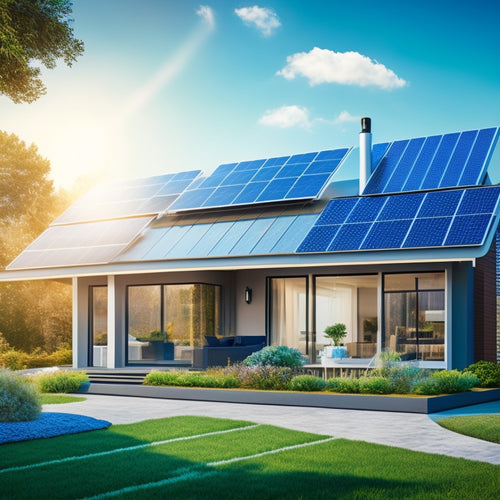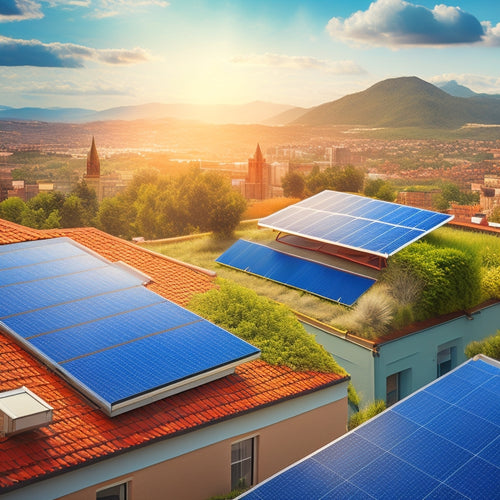
Streamline Your Home's Energy: Integrated Management Solutions
Share
You can optimize your home's energy consumption by identifying areas of inefficiency and implementing integrated management solutions. Daily habits and appliance usage greatly impact energy bills, but real-time monitoring tools can provide useful observations into energy patterns. By streamlining energy distribution, incorporating renewable energy sources, and optimizing energy flow, you can reduce waste and minimize your carbon footprint. Through smart home automation features and energy-efficient design principles, you can make informed decisions about upgrades and replacements. Now, find out how to utilize the full potential of integrated management solutions to change your home's energy environment and start saving today.
Key Takeaways
- Integrated energy management solutions optimize energy consumption, reducing waste and costs through real-time monitoring and data insights.
- Energy-efficient design principles, such as sustainable materials and passive design, minimize artificial lighting needs and energy losses.
- Smart home automation features, including smart thermostats and automated lighting, regulate energy usage and enhance user experience.
- Conducting energy audits and implementing insulation upgrades, appliance efficiency, and behavioral changes can significantly reduce energy consumption.
- Centralized control of energy usage through integrated management solutions enhances convenience, energy efficiency, and overall system harmony.
Understanding Home Energy Usage
Frequently, homeowners are unaware of how their daily habits and appliances impact their energy consumption. You may not realize that your energy consumption patterns are influenced by the efficiency of your household appliances.
For instance, using energy-hungry devices like refrigerators and air conditioners can considerably increase your energy bills. Furthermore, your daily routines, such as taking long showers or leaving lights on, contribute to your overall energy usage.
In addition, considering the installation of solar-powered charging stations can lead to notable energy savings, reducing electricity bills and enhancing sustainability.
By understanding how your habits and appliances affect your energy consumption, you can make informed decisions to reduce your energy bills and carbon footprint.
Analyzing your energy usage helps you identify areas for improvement, allowing you to optimize your energy consumption and achieve a more sustainable lifestyle.
Integrated System Design Principles
When designing an integrated home energy management system, you'll need to contemplate the systematic energy flow throughout your home.
This involves understanding how energy is generated, stored, and consumed in your home, as well as identifying areas where energy is wasted.
By adopting energy-efficient design principles, you can create a system that optimizes energy use and minimizes energy loss.
Incorporating renewable energy sources like solar and wind power can greatly reduce your carbon footprint and reliance on traditional grid electricity.
Systematic Energy Flow
Designing a home energy management system requires a systematic energy flow that integrates various components to optimize energy efficiency.
You'll need to evaluate how energy is distributed throughout your home, ensuring that each component works in harmony to minimize waste. This involves flow optimization, where energy is directed to areas that need it most, reducing unnecessary consumption.
By streamlining energy distribution, you can greatly reduce your energy bills and carbon footprint, much like how Renewable Energy Conversion Kits can decrease greenhouse gas emissions and carbon footprint in fleet vehicles.
Implementing such a system can also lead to notable cost savings from reduced fuel and maintenance.
A well-designed systematic energy flow also enables real-time monitoring and control, giving you the freedom to make informed decisions about your energy usage.
With a systematic approach, you can reveal the full potential of your home's energy efficiency.
Energy Efficient Design
To guarantee peak performance, your home energy management system requires an energy-efficient design that incorporates integrated system design principles. This approach guarantees your home operates in harmony with the environment, reducing its carbon footprint and energy consumption.
Some key elements of energy-efficient design include:
-
Sustainable materials and passive design that minimize the need for artificial lighting and heating/cooling
-
Energy harvesting and thermal insulation to reduce energy losses
-
Daylighting strategies and energy modeling to optimize natural light and energy usage
- By incorporating renewable energy solutions, such as solar panels and wind energy utilization renewable energy solutions, homeowners can markedly reduce their reliance on fossil fuels and lower their carbon footprint.
This approach not only benefits the environment but also leads to long-term cost savings through reduced energy consumption.
Real-Time Energy Monitoring Tools
You'll have greater control over your energy consumption with real-time energy monitoring tools that track your energy use, providing live data revelations into your home's energy patterns.
These tools give you a clear understanding of where your energy is being used, helping you identify areas for improvement.
By integrating renewable energy solutions, such as solar-powered EV chargers, you can optimize your energy usage and reduce your carbon footprint.
Energy Use Tracking
While managing your energy consumption is essential, understanding where and how you're using energy is equally important. This is where energy use tracking comes in.
With real-time energy monitoring tools, you can analyze your energy consumption patterns and identify areas of inefficiency.
- You can pinpoint which appliances and devices are using the most energy
- You can identify opportunities to optimize your usage behavior analysis
- You can make informed decisions about upgrades or replacements to reduce your energy footprint
Live Data Insights
Monitoring your energy consumption in real-time enables you to make data-driven decisions, and that's where live data observations come into play.
With live data revelations, you'll have access to real-time energy monitoring tools that provide a thorough understanding of your energy usage. These tools employ data visualization to present complex data in a clear, easy-to-understand format, allowing you to identify areas of inefficiency and opportunities for improvement.
Additionally, predictive analytics capabilities help you forecast energy consumption patterns, enabling you to optimize your energy usage and reduce waste.
Personalized Alerts
By utilizing the power of real-time energy monitoring, you can take your energy management to the next level with customized alerts.
These custom notifications are designed to your user preferences, ensuring you receive the information you need, when you need it. With personalized alerts, you'll stay informed about your energy usage and be enabled to make data-driven decisions.
- Receive notifications when energy usage exceeds a certain threshold
- Get alerts when an appliance is malfunctioning or inefficient
- Stay informed about energy-saving opportunities and optimization suggestions
Smart Home Automation Features
Your home's automation features are the brain of your smart home energy management system, controlling and enhancing energy consumption with precision. With smart home automation, you can enjoy a range of benefits that elevate your energy management experience.
| Feature | Description | Benefits |
|---|---|---|
| Smart Thermostat | Regulates temperature for peak energy use | Saves energy, reduces bills |
| Automated Lighting | Adjusts lighting levels based on natural light | Enhances ambiance, saves energy |
| Voice Control Integration | Controls appliances with voice commands | Convenient, hands-free control |
| Energy Usage Forecasting | Predicts energy consumption patterns | Helps plan energy usage, reduces waste |
With automated features, you can schedule appliances, access your system remotely, and integrate with security systems. Mobile app control and customizable settings options give you complete freedom to manage your energy usage. Energy consumption analytics provide useful observations to improve your energy management strategy.
Energy Efficiency Optimization Strategies
As you fine-tune your smart home automation features, it's time to focus on the next step: implementing energy efficiency optimization strategies.
This is where you can make a significant impact on reducing your energy consumption and costs.
To achieve this, consider the following strategies:
-
Conduct an energy audit to identify areas of inefficiency and prioritize improvements, such as insulation upgrades and appliance efficiency enhancements.
-
Adopt behavioral changes, like turning off lights and electronics when not in use, to reduce energy waste.
-
Investigate renewable energy sources, like solar or wind power, to supplement your energy needs and promote sustainable practices.
Seamless System Integration Benefits
Harmony in your smart home ecosystem is essential for maximizing energy efficiency and convenience. When all your devices and systems work together seamlessly, you'll experience improved system performance and a more streamlined user experience.
With integrated management solutions, you can effortlessly control and monitor your home's energy usage, temperature, lighting, and security from a single interface. This unified approach eliminates the need for multiple apps and devices, reducing clutter and confusion.
As a result, you'll enjoy enhanced energy efficiency, increased convenience, and a greater sense of freedom in your daily life. By integrating your systems, you'll access the full potential of your smart home, freeing you to focus on the things that matter most.
Maximizing Energy Savings Potential
By leveraging the power of integrated home energy management solutions, you can access significant energy savings potential.
To access these savings, you'll need to identify areas of improvement through energy audits and cost analysis. This will enable you to prioritize behavioral changes, such as optimizing your energy usage patterns, and investing in renewable resources.
Some key strategies to evaluate include:
- Implementing energy-efficient appliance upgrades and insulation techniques to reduce energy consumption
- Exploring financing options and government incentives to support your energy conservation efforts
- Staying up-to-date with advancing energy policies to maximize your savings potential
Frequently Asked Questions
Can Integrated Energy Management Systems Be Installed in Older Homes?
As you ponder the possibilities, rest assured that, yes, you can retrofit older homes with integrated energy management systems, revealing retrofit options that enhance energy efficiency and freedom from wasteful energy consumption.
Are Smart Home Automation Features Compatible With All Energy Providers?
You'll find that smart home automation features aren't always compatible with every energy provider, as limitations exist due to varying smart technology compatibility requirements, so it's crucial to research and confirms compatibility before investing in an automation system.
How Long Does It Take to See Energy Savings With Integrated Systems?
As you unfasten the power of integrated systems, you'll ignite a spark of savings, but patience is key - it may take 6-12 months to see the fruits of your initial investment, yielding long-term benefits that will set your wallet free.
Can Integrated Systems Be Controlled Remotely Through Mobile Apps?
You can control your integrated systems remotely through mobile apps, enjoying remote accessibility and mobile integration that lets you monitor and adjust your home's energy usage from anywhere, at any time, giving you the freedom you desire.
Are Integrated Energy Management Systems Eligible for Government Incentives?
You'll be pleased to know that, yes, integrated energy management systems can qualify for government incentives, which can help offset costs, since they promote energy efficiency and reduce your carbon footprint, giving you more freedom over your wallet and the environment.
Related Posts
-

3 Best Eco-Grants for Home Energy Upgrades
You're eligible for various eco-grants that can help you cut down on energy bills and reduce your carbon footprint by...
-

7 Best Cool Roof Rebates for Energy-Savvy Homeowners
You're an energy-savvy homeowner looking to install a cool roof, and you're wondering which rebates can help you save...
-

What Roofing Materials Best Protect Our Planet?
As you consider the environmental impact of your building, you're likely to find that the roofing material you choose...


